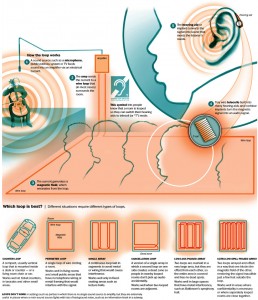Here ‘s a great advocacy blog from Cory Schaeffer about her experience with Hearing Loop technology:
APRIL 3, 2013
With the recent 2012 changes in the Americans with Disabilities Act (ADA), induction loop technology has seen a renewed surge of interest from the hearing impaired community. Induction loop technology wirelessly broadcasts the audio system directly to hearing aids that have a t-coil. It’s widely used outside of North America for assistive listening.
You wouldn’t know it if you talked to me today, but I used to have a bad impression of loop technology, based on an experience more than ten years ago when I first heard a loop receiver. In brief, I was less than impressed and I wondered why anyone would use an induction loop system. (Full disclosure, my company recently embraced induction loop systems.)
The truth is, induction loop is a technology. Like any technology, it has its pros and cons. It’s not fair to jump to a conclusion based on one negative experience — a poorly executed example — and blame the technology, as there are many factors at play. Over the last few years I have learned just what goes into having a well-designed induction loop. Careful planning, designing and execution are critical to having a system that works well.
If an induction loop system is to be installed properly, there are various factors at the installation site that must be taken into consideration. Even coverage, the correct standardized levels to match hearing aids, and a flat frequency response across the desired bandwidth are critically important to proving a positive experience. Taking the time to research and plan the design and installation is necessary because a properly designed, installed and operating hearing loop system delivers tangible benefits to the end-user. The technology needs to be installed correctly and to an IEC standard, which guides the performance of the system and ensures that there is equal coverage throughout the looped area.I’ve seen firsthand the emotional impact that a properly installed induction loop can have on someone experiencing it for the first time. It’s quite visible. You can see their eyes light up. One of our New York City representatives was touched while witnessing a woman experience this technology for the first time. Words could not prepare this woman and she burst into tears when she realized she could not only hear, but hear clearly.
Momentum behind induction loop systems is growing in North America as the hard-of-hearing community demand this technology over others that exist in many venues. People love it because there is minimal action required, making it easier to use. They simply use their t-coil hearing aid as the receiver. For people who do not have a t-coil hearing aid, there are receivers that can also be used with an induction loop system. Make no mistake, induction loop installations can be more complicated than standard RF and IR technologies, but the benefits are well worth the time.
~Cory Schaeffer, Author




